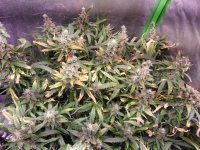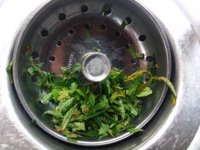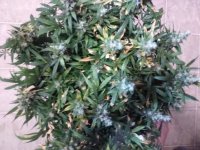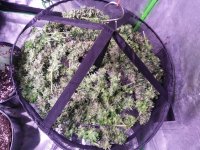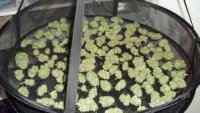- Thread starter
- #301
SQl2kGuy
Well-Known Member
August 25 2019 - Update
Images:
Bakerstreet #1 - Hanna Hemp - Looks healthy so far - budlets are exposed to light and air - limited pruning.
Bakerstreet #2 - Henna Hemp - Looks healthy so far - budlets are exposed to light and air - heavy pruning
C.R.E.A.M. #1 - Cowgirl Hemp - Looks healthy so far - budlets are exposed to light and air - only 8 primary colas.
Cheese #1 - Gouda Hemp - Looks healthy so far - buds are exposed to light and air - only 16 top colas.
Environment #1 - Autoflower Veg/Flower:
I am tracking the RH, canopy temperature and VPD with the Inkbird IBS-TH1.
Environment # 1 is mutually exclusive from Environment # 2.
The exhaust fan is running 24-0 to prevent a rise in temperature & RH, and to prevent smells in the house.
I do not want to turn off the exhaust fan because it will smell up the house.
The humidifier is turned off.
The dehumidifier is turned off.
The three X6 lights are running 1 cycle of "20 hours lights-on and 4 hours lights-off".
Two of the X6 lights are 30 cm (12") above the canopy centered over the 2 flowering plants.
The third X6 light is turned off.
The three X6 lights give off 2°C (4°F) of heat each.
CO2 is refreshed frequently because the exhaust fan and the oscillating fan are always on.
*** The room temperature is running around 26°C (79°F) and RH 43%.
*** The environment humidity is running steady around RH 50% with lights-on.
*** The environment humidity peaks up to RH 65% with lights-off.
*** The environment temperature is running steady around 29°C (85°F) with lights-on.
*** The environment temperature dips down to 22°C (72°F) with lights-off.
*** VPD is running steady about 1.66 - Danger Zone: Over / Under Transpiration - lights-on.
*** VPD is peaking at about 0.65 - LowTranspiration: Propagation/ Early Veg - lights-off.
*** With the exhaust fan on 24-0, it keeps pulling air in from the room.
*** To change the VPD in the tent, I have change the environment parameters in the room.
*** To decrease VPD for lights-on ... I need to either raise the room RH by 5% or decrease the room temp by 2°C (4°F) .
*** The VPD Values I am Using For This Grow (Version 1)
Environment #2 - Photoperiod Flower:
I will start tracking RH, canopy temperature and VPD again when Environment #1 is dialed-in.
Environment # 2 is mutually exclusive from Environment # 1.
The exhaust fan is running 24-0 to prevent a rise in temperature, RH and to prevent smells in the house.
Environment # 2 does not have a humidifier.
Environment # 2 does not have a dehumidifier.
The Mars Hydro TSL 2000W light is running 1 cycle of uninterrupted "12 hours lights-on and 12 hours lights-off".
The Mars Hydro TSL 2000W light is 30 cm (12") above the canopy centered over all plants.
The Mars Hydro TSL 2000W light does not give off a lot of heat.
CO2 is refreshed frequently because the exhaust fan and the oscillating fan are always on.
*** The VPD Values I am Using For This Grow (Version 1)
Growth Stage:
2 Bakerstreets: Day 7/ Week 13 ... Day 91 ... week 5 flower.
*** They got their pistels on August 05, 2019.
*** They are due for the final bloom flush/feed(CGRSFS, BPSS, CS, BTTE) on September 01, 2019.
*** They should be ready to harvest between September 16, 2019 and September 23, 2019.
*** Photoperiod Stages: 5 days Germination, 1 week seedling, 2-8 weeks veg, 6-12 weeks flower, 4-12 weeks cure
*** Allow 1 day to 3 days of dark before switching to 12-12
*** Pistels show up about 14 days (2 weeks) after switching to 12-12
1 C.R.E.A.M.: Day 7/ Week 12 ... Day 84 ... late flower.
1 Cheese: Day 7/ Week 12 ... Day 84 ... late flower.
*** They are in the final 2 weeks ... Flush, Full-On Bloom Nutes, Stem Split, Three Days Dark, Harvest!
*** They should be ready to harvest between August 18, 2019 and August 25, 2019.
*** I need to check the pistels and trichomes to verify the harvest date.
*** Autoflower Stages: 5 days Germination, 1 week seedling, 3 weeks veg, 3 weeks pre-flower, 3-6 weeks flower, 4-12 weeks cure
*** Pistels show up about 35 days (5 weeks) after Germination
*** Flowering takes about 42 days to 56 days (6 weeks to 8 weeks) after pistels show up
Watering and Feeding:
Bakerstreets' Regular Flush/Feed:
*** Next regular feed ... 6 litres (1.6 gallons) - pH 6.3 water - around August 26, 2019.
*** Expecting about 1% of run-off. Stop watering right at run-off.
C.R.E.A.M.'s Bloom Feed:
pH: 6.62
ppm: 1272
4 litres (1.0 gallon) - Full Dose - Week 12 - CGRSFS, CS, BPSS, BTTE
Cheese's Bloom Feed:
pH: 6.62
ppm: 1272
8 litres (2.0 gallons) - Full Dose - Week 12 - CGRSFS, CS, BPSS, BTTE
C.R.E.A.M.'s Bloom Feed & Cheese's Bloom Feed:
*** Next bloom feed ... 6 litres (1.6 gallons) - Full Dose - Week 12 - CGRSFS, CS, BPSS, BTTE around August 28, 2019 .
*** Expecting about 1% of run-off. Stop watering right at run-off.
*** I will do a regular feed(CGRSFS, RME)/feed(CGRSFS, BPSS, CS, BTTE)/water cycle for all regular weeks.
*** I will do full-on bloom feeds(CGRSFS, BPSS, CS, BTTE) for the last two weeks prior to harvest.
*** For details on my feeding schedule refer to here: The Different Feeds I need For This Grow (Version 5)
Activities:
My priority is to expose the growth nodes to light and air because they are going to become colas.
Notes:
The priority has to be to expose the growth nodes/buds to light & air, and to keep the canopy even and flat.
I am going to let the plants grow naturally now and stop tucking the stems into the ScrOG. For details on this decision, please refer here: How long to Veg Photoperiods? - Version 2
I am confident the new Mars Hydro TSL 2000W light is pentrating into the plant, so a lot of pruning is not a good idea.
The Bakerstreets are now getting some height and the budlets are filling out.
I did not prune Bakerstreet #1, it has an even canopy and I am interested in how it will develop.
I did prune Bakerstreet #2 heavily to expose the budlets to light and air and I am interested in how it will develop.
The colas at the ends of the C.R.E.A.M.'s & Cheese's quadline lines are much bigger than the side colas.
The C.R.E.A.M.'s pistels/trichomes & Cheese's pistels/trichomes indicate they are not ready for harvest yet.
With the environment #1 exhaust fan on 24-0, it keeps pulling air in from the room.
To change the VPD in the tent, I have change the environment parameters in the room.
To decrease VPD for lights-on ... I need to either raise the room RH by 5% or decrease the room temp by 2°C (4°F) .
*** I am looking forward to starting my LUX analysis soon.
Lessons Learned:
Cannabis Cultivation: The Light Spectrum and Ways to Raise THC Levels
By RoyalQueenSeeds
Creating an ideal environment for cannabis plants is only achievable by understanding the principles of nature - the light spectrum is a factor that cannot be ignored.
Most cannabis growers have multiple objectives in mind when planning an indoor grow. Drafting scenarios to achieve higher yields, increase THC levels, or simply to improve the overall health of a plant is an integral part of their hobby. This element of strategic planning involves the challenge to link knowledge of different scientific fields and to match those findings to a technical solution that helps to achieve predefined goals. Besides dedication and passion, it is the willingness to learn that differentiates good growers from future experts – so let us try to grow the royal way and learn what it takes to cultivate cannabis of exceptional quality. Today, we are looking at fundamentals of physics, and learn how the light spectrum affects the growth of a cannabis plant.
WHAT IS THE LIGHT SPECTRUM?
The sun emits energy in the form of solar radiation including gamma rays, x-rays, ultraviolet light, visible light, and even radio waves. Life on Earth is only possible because the ozone layer blocks this radiation, and reflects most of it back into space. This filtering process only allows wave lengths between 300nm and 1100nm to reach our plants and an even smaller portion of this light is visible to us. It is often referred to as the light spectrum, color spectrum or visible spectrum, and ranges from 380nm to about 750nm.
180-280nm - UVC: Extremely harmful and luckily almost completely absorbed by the ozone layer
280-315nm – UVB: Cause of sunburn and suspected to increase THC levels (!)
315-400nm – UVA: Not absorbed by the atmosphere, commonly known as black light
380-750nm – The visible light spectrum: Bands of wave lengths represent visible colours
700nm-1mm – Infrared light: Not visible above 750nm but noticeable as heat on our skin
Every organism living on Earth needs information what is going on around them to react to environmental changes, and ideally, get a slight advantage over other members of their species regarding natural selection and evolution. Interestingly, cannabis plants receive a lot of their information from the light they’re exposed to, and almost instantly react to different bands of wave lengths - a complex topic to fill books with, but let us focus on the basics first.
1. Vegetative Stage – “Blue” light for healthy leaves (range: 400-500nm; ideal: 460nm)
During the vegetative stage it is recommended to aim for as many leaves as possible, and to make sure plants stay rather compact, don’t stretch too much, and develop strong stems. Indoor growers tend to use metal halide bulbs, compact fluorescent lamps (CFL’s), or T5/T8 lighting fixtures with a blue band of light for the first few weeks to achieve these goals. When cannabis grows in nature, the high angle of the sun in spring and summer allows more “blue” wave lengths to penetrate through the atmosphere, a signal for cannabis plants to grow strong, large and healthy leaves.
2. Flowering Period – “Red” light for giant buds (range: 620-780nm; ideal: 660nm)
When cannabis plants enter the flowering period, highest yields can be achieved by exposing them to a light spectrum that contains lots of “red” wave lengths to promote budding. The rate of photosynthesis peaks when plants are subjected to “red” wave lengths of 660nm although latest NASA findings suggest that even “green” wave lengths, which are not associated as a major factor in photosynthesis, can also have an impact on how plants grow. Seeing a cannabis plant as simple photosynthesis factory is consequently a little hasty. But for now, choosing a lighting solution with a high degree of “red” in its spectrum remains the best way for growers to imitate the shallow angle of the sun in late summer and autumn.
Have you ever wondered why potent cannabis strains often originate from landraces that naturally grow in high altitude regions? There are experts who suspect ultraviolet light, especially a high exposure to UVB wave lengths (280-315nm), to be responsible for an increased THC production. The theory is based on the fact that a high elevation means lesser atmosphere between cannabis plants and the sun, leading to a higher exposure to UV rays. These ultraviolet wave lenghts knowingly damage our skin, and the human body reacts by producing melanin as protection – a cannabis plant assumingly does something similar – it produces more resin and THC as a form of natural sunscreen. It is too early to say if we are dealing with a theory or a cost-effective method to grow better cannabis but the concept seems plausible enough for hands-on experiments. UVB bulbs for reptiles only cost a few bucks; perhaps we should give it a try.
ToDo:
Learn more about ... When Is the Right Time to Harvest Cannabis Plants?
Learn more about pests and nutrient deficiencies.



